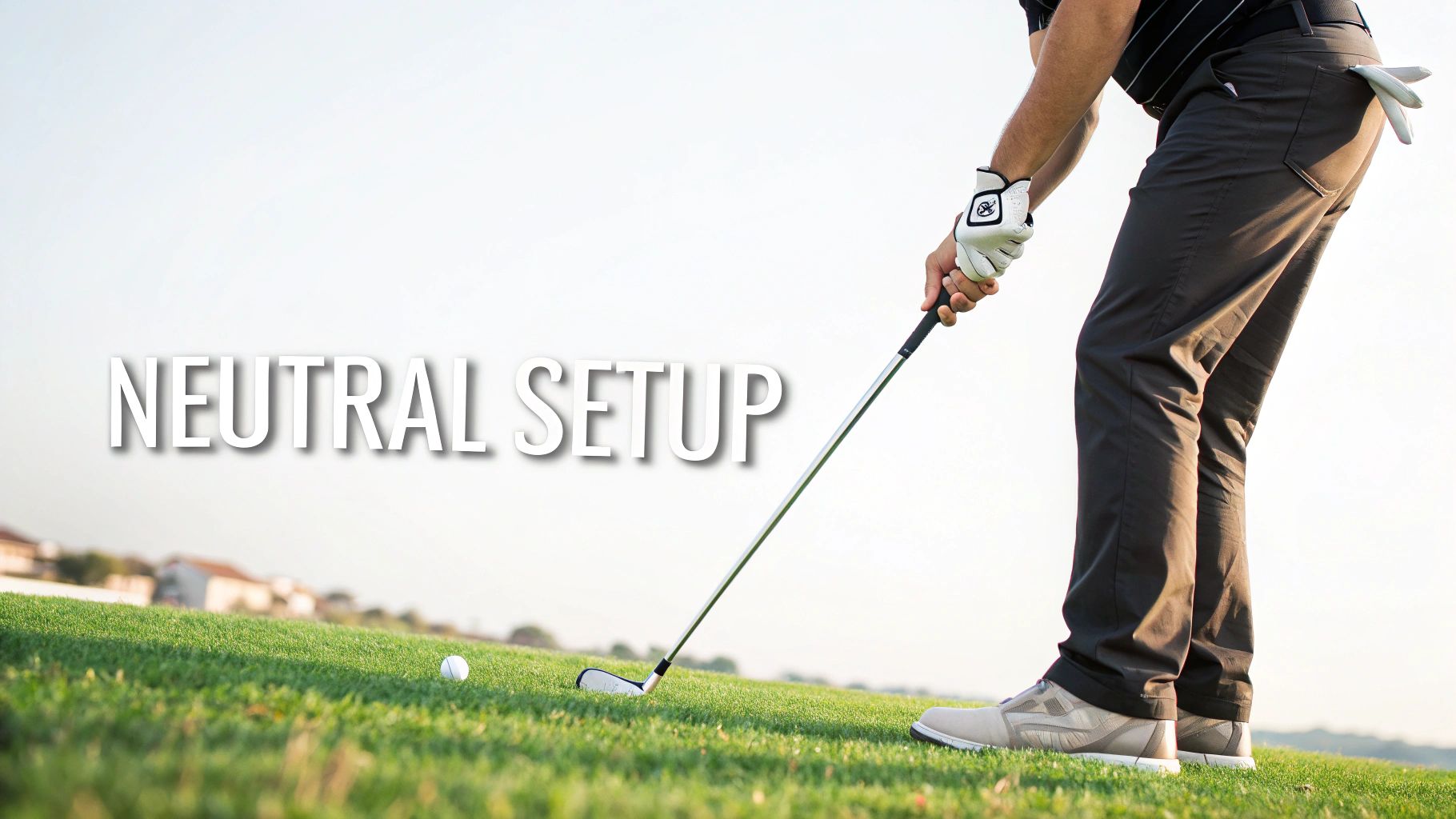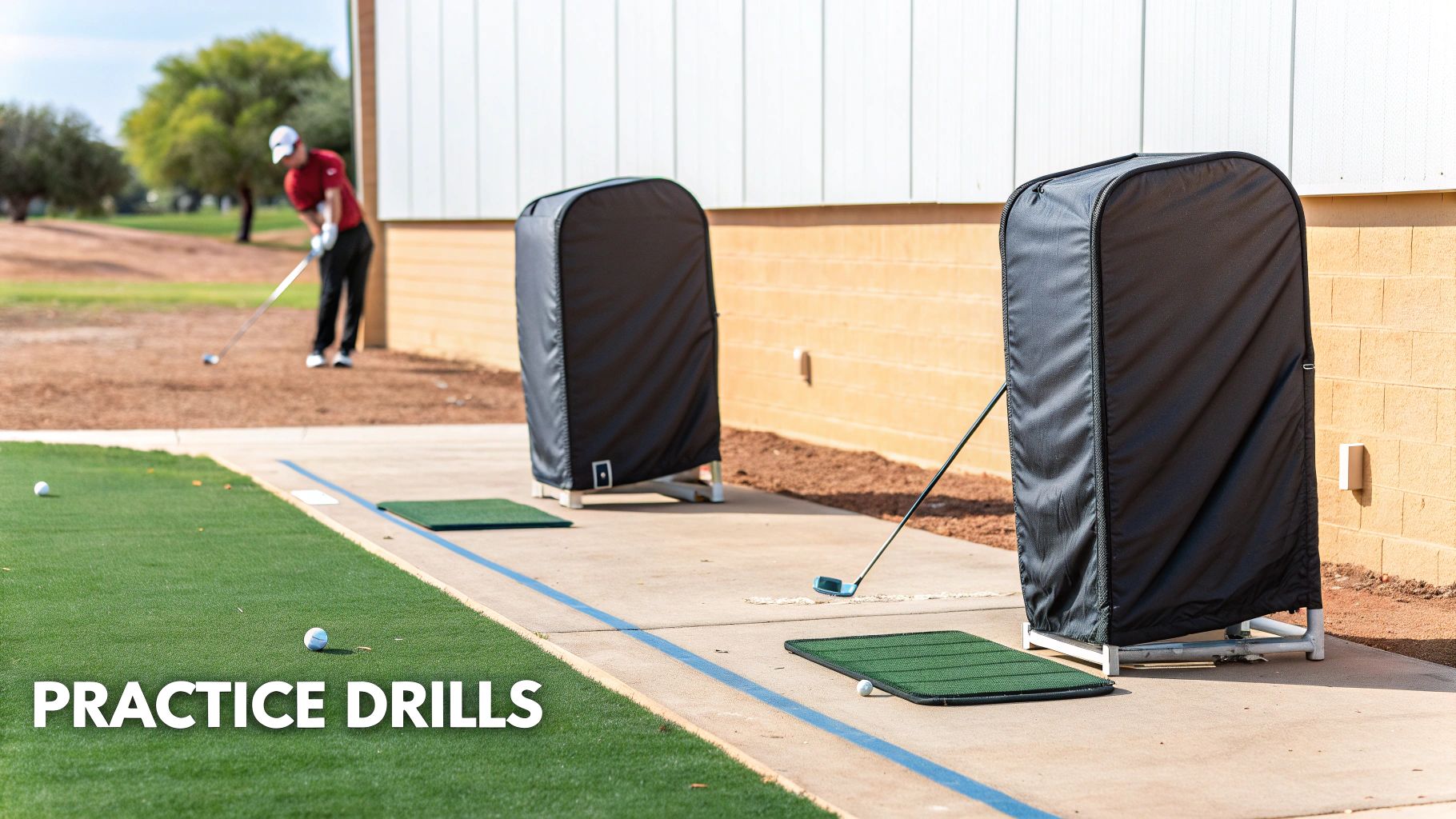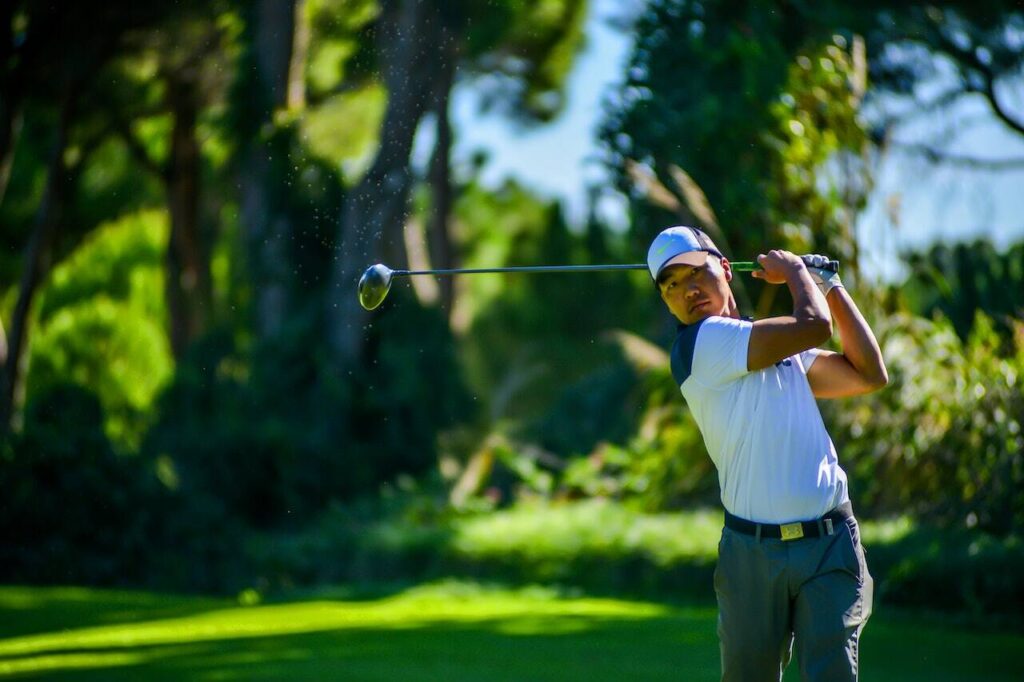How to fix a hook in Golf is a valid question. Alright, let’s get that hook under control. First, you have to accept what’s causing it: at the moment of impact, your clubface is too closed relative to your swing path. That’s the physics of it. But in the real world, the culprit is almost always a small flaw in your setup or swing—usually an overly strong grip, bad alignment, or a swing path that comes too far from the inside. Many struggle with this issue. Knowing how to fix a hook can make all the difference in your game.
Understanding how to fix a hook is essential for any golfer looking to improve their performance on the course. A simple adjustment can lead to more consistent shots.
For those wondering how to fix a hook, remember that even minor tweaks can result in significant improvements. Focus on your grip and alignment.
Don’t worry, this isn’t a massive overhaul. Making a few simple, conscious adjustments in these key areas is your first step toward hitting straighter, more reliable shots you can actually trust.
Why You Are Hooking the Golf Ball
We’ve all been there. You connect with a shot that feels absolutely crushed, only to watch it make a hard left turn and dive into the trees (or, for lefties, a sharp right into trouble). That’s the hook. It’s a frustrating shot because it often feels powerful, yet the result is completely out of control. As you explore how to fix a hook, remember that practice is essential. Stay patient.
The good news? Fixing a hook isn’t about swinging harder or trying to steer the ball down the fairway. It’s about being a detective. You need to identify the specific flaw in your setup or swing that’s causing that clubface to snap shut at the wrong moment. For those seeking how to fix a hook, don’t underestimate the power of mental game adjustments.
Most of the time, the hook culprit is one of these three usual suspects:
- An Overly Strong Grip: This is the big one. If you glance down and can see three or more knuckles on your top hand (your left hand for righties), your hands are in a position that naturally encourages the clubface to shut down through impact.
- Poor Alignment: Many golfers fall into the trap of “playing for the hook” by aiming their body way out to the right of the target. This is a classic mistake that actually makes the problem worse by promoting an even more exaggerated inside-out swing path.
- An Exaggerated Inside-Out Swing: When your club attacks the ball too much from the inside, your hands have to work overtime to try and square the face. This often leads to them over-rotating—or “flipping”—and slamming the door shut, causing that nasty snap hook.
Identifying the Root Cause of a Hook in Golf
So, which one is it for you? Diagnosing your specific issue is the most important step. Think of it like a decision tree: your grip, alignment, and swing path are the main branches, and any one of them can lead to that hook.

This visual guide helps simplify things. It shows how any of these elements—sometimes working together—can create a closed clubface, which is the one and only reason a golf ball hooks.
To give you a quick reference, here’s a breakdown of the most common issues I see on the lesson tee and the first things I check.
Common Golf Hook Causes and Quick Fixes
For golfers curious about how to fix a hook, it’s worth exploring various strategies to overcome this common issue.
| Common Cause | Quick Fix Suggestion |
|---|---|
| Grip Too Strong | Weaken your top hand grip until you only see 1.5 to 2 knuckles. |
| Ball Position Too Far Back | Move the ball slightly forward in your stance (closer to your lead foot). |
| Aiming Too Far Right | Use alignment sticks to ensure your feet, hips, and shoulders are parallel to the target line. |
| Swinging Too Much “Inside-Out” | Feel like you are swinging more “down the line” toward the target post-impact. |
| Hands Are Too “Flippy” | Focus on rotating your body through the shot, not just your hands and arms. |
This table is your starting point. Run through this checklist the next time you’re at the range. More often than not, a small, conscious tweak here is all it takes to see a big difference.
Starting Your Action Plan In Golf
Let’s begin with the easiest and most common fix: your grip. If your grip is too strong, it’s almost impossible to deliver a square clubface without some sort of last-second manipulation. We have a complete breakdown on how to get this right, so check out our guide covering the importance of grip in a hand-by-hand guide.
It’s also worth noting that sometimes, the problem isn’t purely technical. Physical limitations or discomfort, like sciatica, can mess with your posture and rotation, forcing you into bad habits that cause a hook. Looking into something like self-massage for sciatica relief might help address an underlying physical issue that’s showing up in your swing.
By tackling these foundational elements first, you’re not just putting a band-aid on the problem—you’re setting yourself up for a real, long-lasting fix. To further understand how to fix a hook, consider your equipment and its impact on your swing.
Building a Hook-Proof Golf Setup

Here’s something that surprises a lot of golfers: your hook problem often starts long before you even take the club back. The entire pre-shot setup—from how your hands sit on the club to where you place the ball in your stance—is the foundation for your swing. If that foundation is crooked, you can bet the result will be, too.
Let’s move past the generic “just get a neutral grip” advice. Instead, we’ll dive into tangible checkpoints you can use every single time you address the ball. Think of this as your practical guide to building a pre-shot routine that encourages a dead-straight ball flight.
Neutralizing Your Grip in Golf
Your hands are the only part of your body touching the golf club, so how you hold it matters. A lot. The number one cause of a nasty hook is a grip that’s too “strong.”
A strong grip simply means your top hand (the left hand for a righty) is rotated too far over the top of the club. From this position, your hands are practically begging to shut the clubface down through impact, sending the ball left.
To check your grip, just look down at your lead hand.
- Knuckle Check: You should only see 1.5 to 2 knuckles on that top hand. If you can see three or more, your grip is almost certainly too strong. Weaken it by rotating that hand back toward the target.
- “V” Formation: Look at the “V” shape created by your thumb and index finger on both hands. Those Vs should point roughly toward your trail shoulder (your right shoulder if you’re a right-handed player). If they’re pointing way outside that shoulder, your hands are too active.
Even a small adjustment here can make a massive difference in your ball flight. It might feel weird at first, but stick with it. This is a non-negotiable first step.
Perfecting Golf Alignment and Stance
A solid golf setup is your first line of defense against a hook. After you’ve got your grip and alignment dialed in, solid body mechanics are next. It all starts with the basics of maintaining proper posture. Once you’re in an athletic, balanced position, you can finally focus on your aim.
One of the most common mistakes I see is golfers aiming their body way right of the target to “play for the hook.” This is a classic trap that only makes the problem worse by forcing an aggressive inside-out swing path. The real goal is to get everything parallel to your target line.
Your feet, hips, and shoulders should all be aligned parallel to your intended target line, like railroad tracks. The ball is on one track leading to the target, and your body is on the other, parallel track.
Grab a couple of alignment sticks next time you practice. Lay one on the ground pointing at your target, and place the other one parallel to it, just outside your golf ball. This gives you a powerful visual and helps build the muscle memory for what proper alignment actually feels like.
Correcting Your Golf Ball Position
The final piece of this setup puzzle is your ball position. Where you place the ball in your stance has a huge influence on the bottom of your swing arc and your angle of attack. And yes, putting it in the wrong spot can absolutely cause a hook.
When the ball is too far back in your stance, you make contact too early on the in-to-out path. This makes it incredibly easy for the clubface to be closed relative to that path. Here’s a quick reference to keep you on the straight and narrow:
- Driver: Position the ball just inside your lead heel.
- Fairway Woods/Hybrids: About a ball or two back from your lead heel.
- Mid-Irons: Right in the middle of your stance.
- Wedges: Just a touch back of center.
Checking these three key elements—grip, alignment, and ball position—should become a mandatory part of your pre-shot routine. It’s a simple diagnostic you can run on every shot to stop a hook before it ever has a chance to start.
Mastering Your Golf Swing Path and Clubface

Alright, with a solid, hook-proof setup in place, it’s time to dig into the main event: the swing itself. The relationship between your swing path and your clubface at impact is literally the engine behind every shot you hit. For just about every golfer I’ve seen fighting a hook, the club is attacking the ball way too much from the inside, which forces a frantic, last-second hand rotation to try and square things up.
That desperate over-correction is what causes the clubface to slam shut, creating that violent left curve. To finally put an end to the hook, we need to neutralize that path and get a much better handle on the clubface throughout the swing. It’s less about brute force and more about getting everything sequenced correctly.
Avoiding the Dreaded “Stuck” Position in Golf
One of the most common swing killers that leads directly to a hook is getting the club “stuck” behind your body on the downswing. This happens when your arms drop down too far behind you as your body outraces them. From this trapped position, your only move is to aggressively flip your hands and wrists to even make contact—and that move slams the clubface shut every single time.
Think of it this way: your body and arms need to work as a team. If your hips and torso spin open too fast without giving your arms a chance to catch up, the club gets stranded. The secret is to feel like your chest, arms, and club all move down toward the ball together.
Syncing Up Your Body and Arms in Golf
So, how do you stop getting stuck? The key is in the transition at the top of your backswing. Instead of kicking off the downswing with a violent, hip-first turn, try to feel like your lead arm and chest start the movement together. This synchronization is absolutely critical for keeping the club in front of your body where it belongs.
Here’s a great mental image I give my students: Feel like your chest is “covering” the golf ball through impact. This encourages your body to keep rotating through the shot, pulling the club along for the ride, rather than letting your arms and hands take over on their own.
This feeling promotes a much more neutral, down-the-line swing path. It stops the club from getting too far inside and forces a more passive release, which is exactly what you need to straighten out that ball flight. It’s the difference between a powerful, body-driven swing and a handsy, unreliable one.
Developing Golf Clubface Awareness
Now, let’s talk clubface. A lot of golfers who hook the ball are simply unaware of where the face is pointing during their swing. They might have it perfectly square at address, but by the top of their backswing, it’s often completely shut (pointing skyward). From that position, it’s almost impossible to deliver a square face at impact.
Developing clubface awareness is a total game-changer. You have to learn what a square clubface feels like at key checkpoints in your swing.
- Halfway back: When the club is parallel to the ground, the toe of the club should point straight up to the sky. If it’s already tilting behind you, the face is shut.
- At the top of the swing: The clubface should be parallel to your lead forearm. For most people, this means it will be angled at about 45 degrees to the ground. If the face is pointing straight at the sky, it’s shut.
A really simple way to check this is to just stop your swing at these two positions during practice. Take a peek at the clubface. This instant visual feedback is incredibly powerful for building the right feel. Eventually, you won’t even have to look—you’ll just know. Remember, fixing a hook is as much about feel as it is about mechanics.
Proven Drills to Straighten Your Golf Ball Flight
Don’t forget the importance of drills when figuring out how to fix a hook. They provide valuable feedback.

Knowing why you hook the ball is one thing. Actually ingraining a new, straighter swing into your muscle memory is a whole different ball game. This is where we leave the theory behind and get our hands dirty on the turf.
Drills are the essential bridge between understanding what to do and being able to pull it off under pressure. These aren’t just random exercises; they’re designed to give you instant, undeniable feedback, helping you feel the correct movements instead of just thinking about them.
Let’s dig into some of the most effective drills I’ve seen work wonders for students, whether you’re at the range or just practicing your motion at home.
The Gate Drill for a Neutral Golf Swing Path
A swing path that comes too far from the inside is probably the biggest hook culprit out there. The Gate Drill is a classic for a reason—it gives you immediate, black-and-white feedback on your path.
Simply set up two headcovers, water bottles, or even a couple of towels on the ground. You’re creating a “gate” just wide enough for your clubhead to pass through on its way to the ball. Your goal is to position this gate so that a perfectly square swing path sails cleanly through the middle.
- The Goal: Swing through the gate without bumping into either side. Easy, right?
- The Feedback: If you smack the inside object (the one closer to you), your path is still coming too far from in-to-out. Hit the outside one, and you’ve overcorrected.
- The Feeling: You’ll start to feel your arms and club working more “down the line” toward your target after impact, rather than chasing the ball way out to the right.
This drill flat-out forces you to neutralize your swing path. It’s a non-negotiable step to finally kicking that hook to the curb. For even more ways to dial in your alignment, our guide on effective golf alignment stick drills has you covered.
The Feet-Together Golf Drill for Better Rotation
I see this all the time: hooks caused by a wild, “armsy” swing where the hands and wrists flip over way too fast. This drill is brilliant because it basically takes your arms out of the equation and forces your body to do the work. The result is a much better, more connected sequence.
It’s as simple as it sounds. Address the ball with your feet touching each other. From this ridiculously narrow base, just hit some smooth, easy shots with a wedge or 9-iron. You won’t be able to generate much power, and that’s precisely the point.
This drill makes it nearly impossible to slide or sway. To hit the ball even remotely solid, you are forced to rotate your chest and core through the shot. This instantly quiets down those overactive, hook-producing hands.
If you try to swing with just your arms, you’ll lose your balance immediately. It’s a fantastic exercise for syncing up your body’s rotation and improving your overall balance at the same time.
The Split-Hands Golf Drill for Clubface Awareness
This last one is all about developing a feel for where the clubface is pointing throughout your swing, without having to peek. It’s a simple but incredibly powerful way to train your hands to work properly through the impact zone.
Take your normal grip on the club. Now, just slide your trail hand (the right hand for a right-handed golfer) down the shaft about four to five inches. From here, make some slow, half-swings, really paying attention to how your lead wrist is controlling the clubface.
- To Stop Hooking: Get the feeling that the back of your lead hand is pointing at the target for as long as possible after you hit the ball.
- What It Prevents: This simple change stops your trail hand from overpowering your lead hand and aggressively rolling the clubface shut too early.
Practicing this will give you an incredible sense of control over the clubface. Once you have a neutral path and a square face, that hook doesn’t stand a chance.
On-Course Adjustments When the Golf Hook Returns
It’s one thing to groove a perfect swing on the practice range, but it’s a whole different ball game when that nasty hook reappears on the 7th hole. You can’t rebuild your swing mechanics mid-round. What you can do is make smart, temporary adjustments to stop the bleeding and salvage your score.
When that dreaded left curve shows up, your first job is damage control. Stop trying to force a perfectly straight shot—that’s a recipe for disaster. Instead, play the shot you have. A great mental cue is to feel like you’re trying to hit a gentle fade, even if the ball flies dead straight.
This simple thought encourages your body to hold off that aggressive, hook-causing hand rotation through impact. You’re not actually trying to produce a fade; you’re just preventing the big miss left. In summary, knowing how to fix a hook can change your game drastically, enabling you to hit straighter shots.
Smart Golf Course Management
Strategic thinking becomes your best friend when the hook crashes the party. Instead of automatically pulling the driver on a tight hole, think about a club that minimizes the damage. A 3-wood or even a hybrid might be the smarter play. Remember, less loft means more curve, so a more forgiving club is a savvy choice.
You also need to aim for the safe side of the fairway or green. If the right side is wide open and the left is guarded by a lake, aim down the right half.
Playing to the safe side isn’t being timid; it’s being smart. You’re acknowledging the shot you’re likely to hit under pressure and giving yourself the largest possible margin for error to avoid a round-killing score.
Quick Mental and Physical Cues in Golf
You can also try a couple of subtle setup tweaks. A slightly weaker grip—turning your top hand just a fraction toward the target—can instantly quiet down your hands through the ball.
Another quick fix is to feel like your chest stays pointing down at the ball for just a split second longer. This feeling prevents an early, aggressive body rotation that gets the club stuck behind you and forces your hands to flip over.
These on-course fixes are designed purely to get you through the round. The intricate parts of the golf swing sometimes mirror the precision found in other high-performance equipment. For instance, the global fishing reels market, which often involves its own kind of hook mechanisms, was valued at USD 7.2 billion in 2025 and is projected to hit USD 11.9 billion by 2035. You can discover more insights about this growing market on Future Market Insights. The key takeaway for both golfers and anglers is that small, precise adjustments can make a huge difference in performance.
FAQ’s
Even with the best drills and swing thoughts in the world, nagging questions always seem to pop up when you’re trying to fix a hook. It’s one of golf’s most stubborn problems, and sometimes you just need a quick, straight answer to what’s happening on the course. Let’s tackle a few of the most common questions I hear from golfers battling that nasty leftward curve. Have questions about how to fix a hook? You’re not alone.
Why Do I Still Hook My Driver but Not My Irons?
This one’s a classic, and it drives people nuts. The driver is the longest club in your bag and has the least amount of loft, which means any tiny flaw in your swing gets magnified—big time. An in-to-out path or a closed clubface that might produce a gentle draw with a 7-iron can easily turn into a snap hook with the big stick.
On top of that, a lot of golfers subconsciously open their shoulders at address with the driver, trying to “help” the ball up into the air. This almost always leads to an over-the-top move, which they then have to save by flipping their hands through impact. That’s a textbook recipe for a hook. With your irons, the swing is shorter and more compact, which can often hide those same flaws.
Can My Equipment Cause a Hook?
Oh, absolutely. While your swing is almost always the main culprit, your gear can definitely be an accomplice. An ill-fitting driver can make hitting a straight shot feel nearly impossible.
A few things to check:
Shaft Flex: If your shaft is too flexible for your swing speed (too “whippy”), the clubhead can lag behind on the downswing and then snap shut right at impact. Hello, hook.
Lie Angle: This is a big one. If the lie angle on your clubs is too upright for you, the heel of the club digs into the turf first, forcing the toe to slam shut and send the ball left.
Driver Settings: Most modern drivers are adjustable. If yours is cranked into a “draw” setting, it’s designed to close the clubface for you, which is the last thing you need if you’re already fighting a hook.
A professional club fitting can be a total game-changer. It’s the only way to be certain your equipment is working with your swing instead of against it. A good fitter can spot a weak shaft or an incorrect lie angle in minutes, potentially fixing a problem you’ve been fighting for years.
If you feel like you’ve tried every swing fix under the sun and you’re still hooking it, do yourself a favor and get your clubs checked. It just might be the missing piece of the puzzle.
At Golf Inquirer, we’re obsessed with helping you play better and enjoy the game more. For more guides and honest gear reviews, check out everything we have to offer at https://golfinquirer.com.



